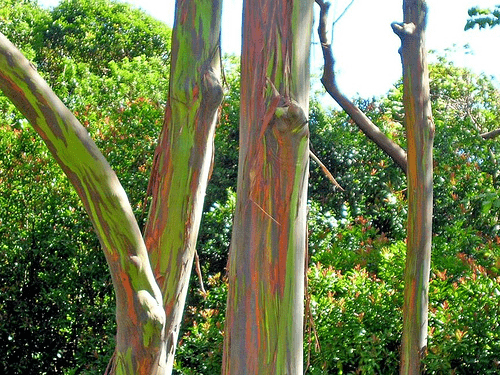The Most Beautiful Tree in the Philippines, Ranked
Voting rules: Choose the tree you think is the most beautiful!

Updated on May 4, 2024 06:20
Ranking the most beautiful tree in the Philippines can be a helpful guide for both locals and tourists who cherish natural beauty. By highlighting distinctive trees, this list serves as an educational tool and promotes ecological awareness. It not only showcases the diverse flora of the region but also encourages active participation and appreciation for nature's unique aesthetics.
This live ranking is continuously updated based on user votes, reflecting current public opinion and interest. As a user, your vote contributes to determining which tree stands out among its peers for its beauty and significance. Engage with the community and help shape this dynamic list by casting your vote for the tree you find most beautiful.
What Is the Most Beautiful Tree in the Philippines?
-
170votesThe Narra tree is considered the national tree of the Philippines and is known for its beautiful and durable wood. It also produces yellow flowers that add to its beauty.The Narra Tree, also known as Pterocarpus indicus, is a majestic tree native to the Philippines. It is celebrated for its stunning beauty and valuable timber. The Narra Tree belongs to the Fabaceae family and can grow up to 30 meters tall. Its crown is wide and rounded, providing ample shade. The tree has a straight trunk that can reach a diameter of up to 2 meters. The Narra Tree's bark is rough and grayish-brown in color. Its leaves are compound, with each leaflet having a glossy dark green color. The flowers of the Narra Tree are small and yellow in color, forming in clusters. The fruits are elongated pods containing seeds. The Narra Tree is known for its strong and durable wood, often used in construction and furniture-making. Its timber displays a rich, dark red color and a beautiful grain pattern. The tree is also considered sacred and symbolizes strength and resilience in Philippine culture.
- Scientific Name: Pterocarpus indicus
- Family: Fabaceae
- Height: Up to 30 meters
- Trunk Diameter: Up to 2 meters
- Crown Shape: Wide and rounded
-
239votesThe Banaba tree is known for its beautiful purple flowers that bloom in the summer months. It is also used for medicinal purposes in traditional Filipino medicine.The Banaba Tree, scientifically known as Lagerstroemia speciosa, is a majestic flowering tree native to the Philippines. It is renowned for its exquisite beauty and is often considered one of the most visually stunning trees in the country. Standing tall and grand, the Banaba Tree is adorned with large, vibrant and colorful flowers that cover the entire tree during its blooming season, creating a mesmerizing spectacle for nature lovers and visitors.
- Tree Height: Can reach up to 20 meters
- Leaf Type: Deciduous, oval-shaped
- Fruit Type: Capsule
- Scientific Name: Lagerstroemia speciosa
- Native to: Philippines
-
315votesThe Molave tree is known for its strong and durable wood, and is often used for furniture and boat building. It also produces fragrant white flowers.The Molave Tree is considered one of the most beautiful trees in the Philippines. It is a medium-sized evergreen tree known for its majestic appearance and sturdy structure. The Molave Tree can reach a height of up to 25 meters and has a dense crown of dark green foliage. Its trunk is thick and smooth, with a grayish-brown bark that exudes a subtle sheen. The Molave Tree produces small, fragrant white or cream-colored flowers that attract various pollinators. Its wood is highly durable and resistant to decay, making it valuable for construction and furniture-making.
- Height: Up to 25 meters
- Foliage Color: Dark green
- Flower Color: White or cream
- Wood Durability: Highly durable and resistant to decay
- Growth Habit: Evergreen
-
414votesThe Sampaloc tree produces delicious and sour fruits that are commonly used in Filipino cuisine. It also produces pink and purple flowers that bloom during the summer months.The Sampaloc Tree, scientifically known as Tamarindus indica, is a magnificent tree that is appreciated for its beauty and cultural significance in the Philippines. Its name, 'Sampaloc', refers to the tamarind fruit it bears.
- Height: Can grow up to 25 meters
- Canopy: Wide-spreading and dense, providing ample shade
- Leaves: Feathery and fern-like, composed of pinnate leaflets
- Flowers: Small, yellow, and fragrant, arranged in clusters
- Fruit: Produces pods containing edible pulp with a sweet and tangy taste
-
519votesThe Balayong tree produces beautiful pink flowers that bloom in the spring months. It is commonly found in the island of Palawan.The Balayong Tree, also known as the Philippine Cherry Blossom, is a stunning flowering tree native to the Philippines. It belongs to the rose family and is scientifically known as Cassia nodosa. The tree is particularly famous for its abundant display of delicate pink flowers that cover its branches during the flowering season.
- Scientific Name: Cassia nodosa
- Common Name: Balayong Tree or Philippine Cherry Blossom
- Family: Rosaceae
- Flower Color: Delicate pink
- Native Habitat: Philippines
-
615votesThe Philippine Teak tree is known for its beautiful wood and is often used for furniture and construction. It also produces fragrant white flowers.The Philippine Teak Tree, scientifically known as Tectona philippinensis, is an evergreen tree native to the Philippines. It is considered one of the most beautiful trees due to its stunning appearance and valuable timber. The tree can reach a height of up to 30 meters and has a straight trunk with a diameter of around 1 meter. The leaves are dark green and glossy, arranged in opposite pairs along the branches. When the tree blooms, it produces small, fragrant white flowers that attract pollinators like bees and butterflies. The fruits are oval-shaped and contain tiny seeds which facilitate its propagation.
- Scientific Name: Tectona philippinensis
- Height: Up to 30 meters
- Trunk Diameter: Around 1 meter
- Leaf Color: Dark green
- Flower Color: White
-
76votesThe Malabulak tree produces beautiful white and pink flowers that bloom in the summer months. It is also used for medicinal purposes in traditional Filipino medicine.The Malabulak Tree, scientifically known as Delonix regia, is a majestic flowering tree native to the Philippines. It is commonly called the Flame Tree or Royal Poinciana for its vibrant red or orange flowers that cover the tree during the flowering season. The Malabulak Tree is renowned for its stunning beauty and is often considered one of the most beautiful trees in the country.
- Scientific Name: Delonix regia
- Common Names: Malabulak Tree, Flame Tree, Royal Poinciana
- Origin: Philippines
- Flower Color: Red or Orange
- Flowering Season: Usually in summer or spring
-
83votesThe Yakal tree is known for its strong and durable wood, and is often used for furniture and construction. It also produces small white flowers.The Yakal Tree, scientifically known as Shorea astylosa, is a majestic and iconic tree native to the Philippines. It is renowned for its stunning beauty, remarkable size, and valuable timber. The creator of this incredible tree is Mother Nature herself, who has blessed the Philippines with a rich biodiversity.
- Height: The Yakal Tree can reach an impressive height of up to 60 meters (197 feet).
- Diameter: It boasts a diameter of approximately 1.5 meters (4.9 feet) or more.
- Canopy: The Yakal Tree has a dense, wide-spreading canopy that provides ample shade.
- Leaves: Its leaves are ovate, dark green, and glossy, giving the tree a lush appearance.
- Flowers: The Yakal Tree produces small, inconspicuous flowers that turn into olive-like fruits.
-
910votesThe Bagras tree produces beautiful yellow flowers that bloom in the summer months. It is commonly found in the island of Mindanao.The Bagras Tree is a large, majestic tree native to the Philippines. With its impressive height and stunning crown, it is considered one of the most beautiful trees in the country.
- Scientific Name: Eucalyptus deglupta
- Common Name: Bagras Tree
- Height: Reaches up to 60 meters (197 feet)
- Trunk Diameter: Can exceed 200 centimeters (79 inches)
- Leaves: Oval-shaped and glossy green
-
107votesThe Kamagong tree is known for its beautiful and durable wood, and is often used for furniture and decorative items. It also produces small white flowers.The Kamagong Tree, also known as Diospyros blancoi, is a tall and majestic tree native to the Philippines. It is renowned for its dark, almost black hardwood that is highly prized for its beauty and durability. The tree can reach heights of up to 30 meters and has a dense, rounded crown with dark green glossy leaves. Its small, fragrant flowers bloom in clusters and are followed by small fruits that turn from green to orange when ripe. The Kamagong Tree is often considered one of the most beautiful trees in the Philippines due to its striking appearance and cultural significance.
- Scientific Name: Diospyros blancoi
- Height: Up to 30 meters
- Wood Color: Dark, almost black
- Leaf Color: Dark green
- Leaf Type: Glossy
Missing your favorite tree?
Graphs
Discussion
Ranking factors for beautiful tree
-
Aesthetic appealThe overall beauty of the tree should be considered, including its shape, color, and distinct features like bark texture, foliage, and flowers.
-
Size and ageOlder, larger trees often have a more majestic appearance and historical significance, which can contribute to their beauty ranking.
-
Rarity and uniquenessTrees that are native to the Philippines, or are rare species, can be ranked higher due to their uniqueness and cultural significance.
-
Cultural importanceA tree may hold historical or cultural significance in the Philippines, such as being part of a legend, a landmark, or an important symbol. This can affect its overall beauty ranking.
-
Environmental benefitsThe ecological value and importance of the tree in its ecosystem, such as its role in providing habitat and food for wildlife, can also be a factor in ranking its beauty.
-
Seasonal changesSome trees may look more beautiful during a specific season when they have flowers, fruits, or colorful foliage. Consider how the tree looks throughout the year.
-
Surrounding environmentThe setting in which a tree is found can contribute to its beauty, such as if it's found in a picturesque location, in a historical site, or as part of a well-designed landscape.
-
Public opinionConsider the opinions of locals and tourists who have experienced the tree firsthand or seen pictures of it, as their perspectives may offer insights into the tree's beauty.
-
Resilience and adaptabilityTrees that can withstand harsh environmental conditions or adapt to changing climates, while still maintaining their beauty, may be ranked higher in the list.
-
Overall impactLastly, take into account the tree's overall impact on people, such as inspiring awe, wonder, or a sense of connection to nature.
About this ranking
This is a community-based ranking of the most beautiful tree in the Philippines. We do our best to provide fair voting, but it is not intended to be exhaustive. So if you notice something or tree is missing, feel free to help improve the ranking!
Statistics
- 1570 views
- 194 votes
- 10 ranked items
Voting Rules
A participant may cast an up or down vote for each tree once every 24 hours. The rank of each tree is then calculated from the weighted sum of all up and down votes.
Trendings topics
Don't miss out on the currently trending topics of StrawPoll Rankings!
More information on most beautiful tree in the philippines
The Philippines boasts a rich biodiversity, with over 7,000 islands and a wide range of ecosystems. One of the most striking features of the country's natural landscape is its stunning array of trees. From towering dipterocarps to delicate fruit trees, the Philippines is a veritable paradise for tree lovers. In this article, we'll explore some of the most beautiful trees in the Philippines, and learn more about their unique characteristics and cultural significance. So whether you're a nature enthusiast or simply curious about the natural world, read on to discover the beauty and diversity of Philippine trees.
Explore other rankings
Check out some of the other recommended rankings on StrawPoll and make your voice heard.

